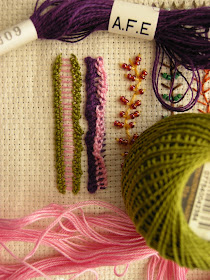First take a look at, or indeed join TAST and learn, the stitch at Pintangle. Then you will know what it should look like. Sharon B, our teacher, always produces stitches that are neat and tidy.
My first attempt was on the Aida sampler, where I used a purple linen thread and a pink coton a broder. These types of thread have very little twist and the result is - appalling! Green perle 8 behaved better.
Please note, though, that going down the left side of the 'ladder' base stitches the thread sits neatly whereas working the thread in the different direction, as seen on the right side, the thread WILL twist and misbehave.
On my sampler I switched to a newly acquired hand dyed variegated perle 5,
and to a strange 'thread' or should I say nylon string, that I picked up at FOQ some years ago.
Both of these threads have a good twist which help to produce much better results.
Even so the movement of the stitch makes the thread curl up and misbehave a bit.
One TAST participant said it was hard to find where to insert the needle for the second knot. Here is how I solved that problem:
Step 1. Make the first Buttonhole loop.
Step 2. Insert the needle in the loop before you tighten the first knot.
Step 3. Tighten the knot around the needle.
Step 4. Pull the needle through and gently pull the thread to knot the second loop. Use your thumb to hold the thread in place.
Step 5. Pull tight.
In the end I liked this stitch so much I am now off to play with the next one, #137 Beaded Knotted Buttonhole Bar. My report on that one will be posted later.
Happy stitching!








Good solution to what could become a real problem. I think you have it mastered.
ReplyDeleteYes, I think so, too. I feel like a ring master in a circus, controlling the tigers with a whip!
Deletethis looks tricky Queenie but you have certainly mastered it on the evenweave and the cushion. Have now got a pinterest board where I am now saving llt the tast stitches to I find on blogs for easy reference
ReplyDeleteIt is actually easier than it looks like. Once you get the hang of it it is fast and fun. Good idea to collect TAST stitches on pinterest.
DeleteI also tried it on a curve and it is working perfectly. You made still diminishing lines - very tricky and inventive.
ReplyDeleteTo space the base stitches evenly in a curve you need a marker and some care. The knotted stitches don't want to sit still on the curve, though, as they are not anchored in the base fabric but slide on the foundation stitches.
Deleteyour explanations are very clear it'll help me when I'll try this stitch.
ReplyDeleteGood, I hope you'll find it easy.
DeleteThanks for sharing your method, I'm sure this will work well. Love your new perle 5, it's a nice soft colour combo.
ReplyDeleteI hope everyone will fall in love with this tricky stitch.
DeleteThe new perle 5 is a delight to work with and you saw the neat result, too.
Hi Queenie - your comments about a good twist on the thread are spot on and aso your demo for the second knot. Great samples!
ReplyDeleteThank you, Miss.
DeleteI am so happy to build my stitch knowledge and skills through TAST.
Fabulous explanation and troubleshooting Queenie, I was just about to type in Sharons very comment.......Great minds think alike ! You are a fine source of information and I enjoy and learn from you..........Thank you ! Have a great week dear friend.
ReplyDeletehugs
Chris Richards xx
It is always nice to be able to share problems and how to solve them. We all sit alone and stitch but still have this fabulous global network of fellow needle workers, so no one should have to be alone with a stitch problem. Sharing is important. Being kind is even more important, and I am so happy to have your friendship, dear Chris. You, too, have a good week.
DeleteThank you Queenie xxx
DeleteI was introduced to this stitch a few years ago and enjoyed doing it, but I've never tried it on a curve, so that will be my challenge following your excellent instructions of course.
ReplyDeleteBe aware that the stitches on the outer edge of the curve might slide towards the centre if you tighten the knot too closely. Two solutions, 1) give a little slack to the thread between the knots or 2) pack another row of knots onto the foundation bars so the stitches sit tight.
DeleteHave fun!
OK, thanks for the tips.
DeleteLadder stitch, very versatile, fun.
ReplyDeleteIt is a great stitch for crazy quilting - you only need to do the foundation stitches through all layers, the Knotted Buttonhole stitches are all on the surface.
DeleteThis looks a nice stitch, you have mastered it very well and put it to good use as always.
ReplyDeleteHi Susan,
DeleteYou really need the right thread to master this stitch.
Hi Queenie, I have been following you for many years, along with fat quarter. You both are one of my favorite embroiderer bloggers. Your works are very beautiful and creative, I like how you combine and add surface stitches. The nylon thread is used mostly for macrame, I know it, because I follow groups in Facebook, and I have one. It is a nice soft thread.
ReplyDeleteHi Angelica.
DeleteThank you for reading my blog and your kind comment.
I had no idea what the nylon thread was for when I bought it and thought it was a mistake at first as it is so stiff (not soft) but it came in handy for stubborn stitches that need a 'firm hand'.
Macrame was very popular in Sweden in the 70s, but I have no idea of if and when it was in Japan.